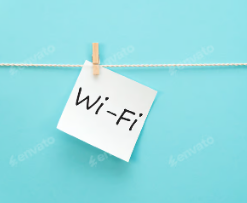Several factors and physical obstacles can interfere with the signal of a Wi-Fi router, causing reduced performance and connectivity issues. Here are some common obstructions:
- Walls and Barriers:
- Thick walls, especially those made of concrete, brick, or metal, can significantly weaken Wi-Fi signals. Doors and partitions can also pose challenges, depending on their material and thickness.
- Furniture and Large Objects:
- Large pieces of furniture, such as bookshelves, cabinets, and couches, can block Wi-Fi signals. Even smaller objects, like potted plants, can cause some interference, especially if they are dense or made of certain materials.
- Electronic Devices:
- Appliances and devices that emit electromagnetic interference can disrupt Wi-Fi signals. Common culprits include microwaves, cordless phones, baby monitors, and some Bluetooth devices.
- Floors and Ceilings:
- In multi-story buildings, the floor and ceiling materials can obstruct signals. Wi-Fi signals can have difficulty penetrating multiple levels, leading to weaker connections on different floors.
- Windows and Glass:
- While glass is generally less obstructive than solid walls, certain types of glass (e.g., low-emissivity or tinted windows) can contain materials that block or reflect signals.
- Metal Objects:
- Metal objects, including filing cabinets, metal shelves, and appliances, can create significant interference and reflect Wi-Fi signals, preventing them from reaching their intended destination.
- Distance from the Router:
- The further you are from the Wi-Fi router, the weaker the signal will be. Even if there are no physical barriers, distance can diminish the signal strength.
- Network Congestion:
- While not a physical obstruction, the number of devices connected to the network can impact performance. Overloading the router with too many devices can lead to slower speeds and connectivity issues.
Tips to Improve Wi-Fi Signal
To minimize obstructions and enhance your Wi-Fi performance, consider the following tips:
- Position the Router Wisely: Place your router in a central location, raised off the floor, and away from walls or large objects.
- Use Wi-Fi Extenders or Mesh Systems: If you have a large area to cover, consider using Wi-Fi extenders or a mesh network to ensure better coverage.
- Reduce Interference: Keep the router away from other electronic devices that could cause interference, and use wired connections for devices that require stable connections.
- Upgrade Equipment: If your router is older, consider upgrading to a newer model that offers better range and performance.
Taking these factors into account can help ensure you achieve optimal Wi-Fi performance in your environment.
